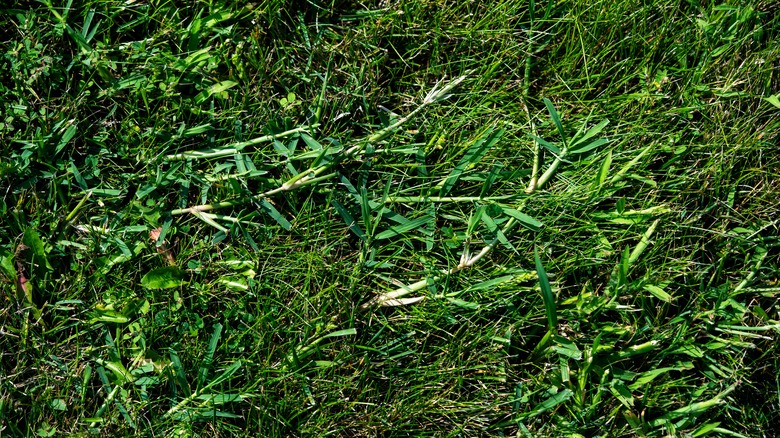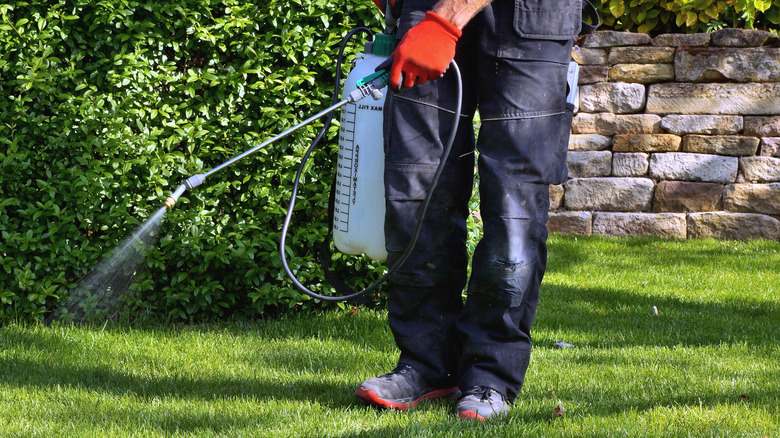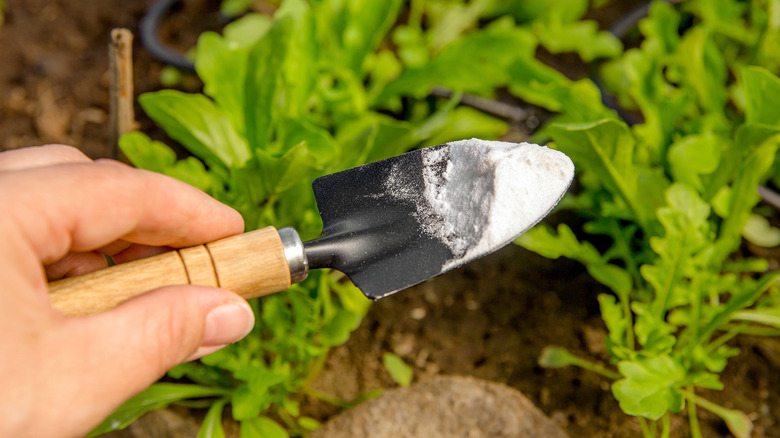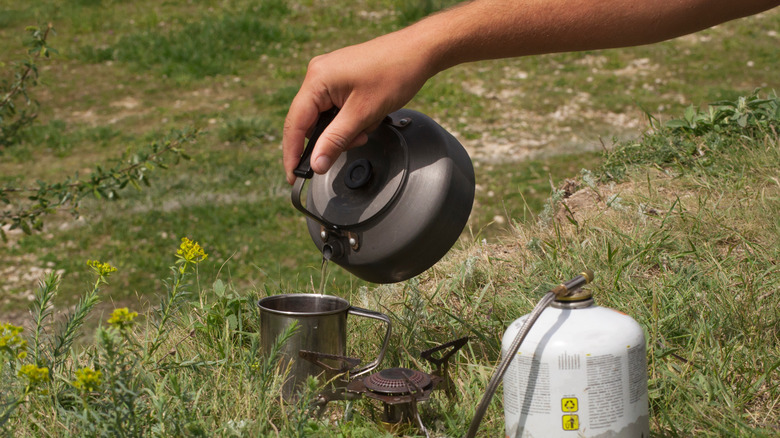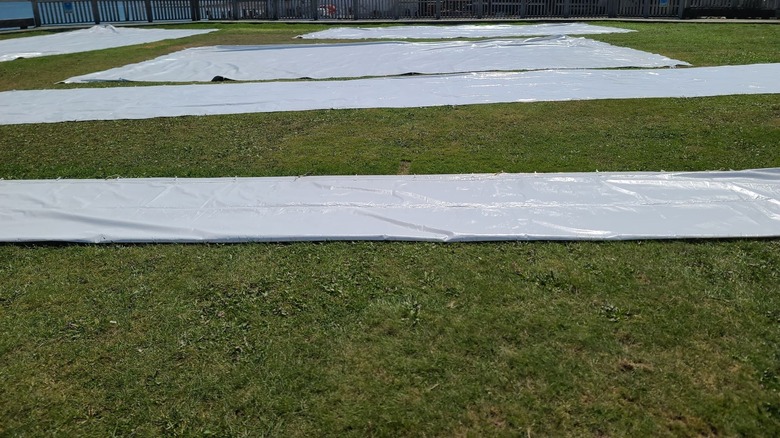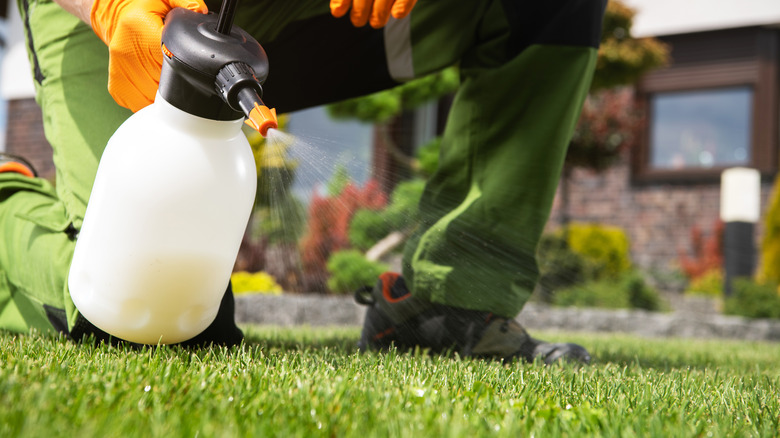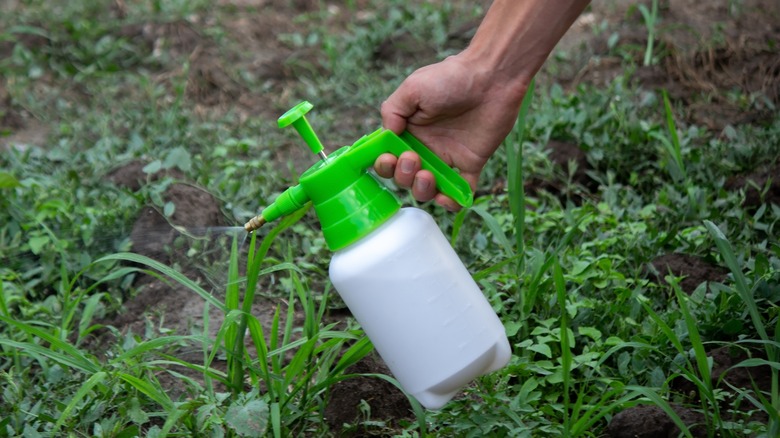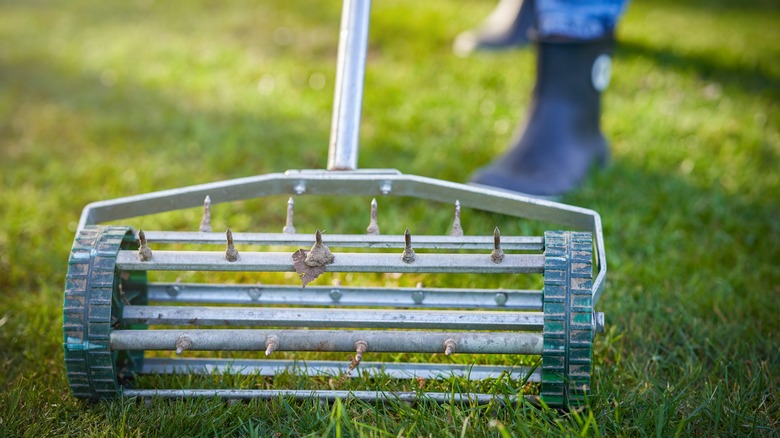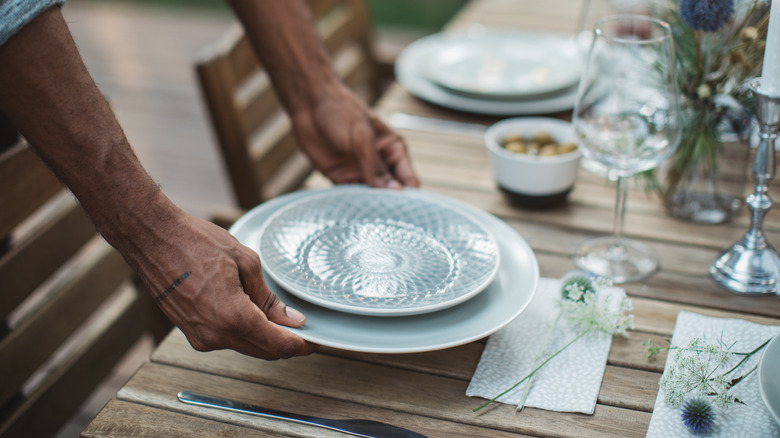8 Genius Tips And Tricks For Killing Crabgrass In Your Lawn
A small patch of crabgrass can quickly turn into a major problem if you don't take steps to get rid of it early on. You might think about pulling it out by hand or keeping up with regular lawn maintenance as solutions. However, there are also other, less common ways specifically designed to tackle crabgrass without harming your lawn, flowers, or shrubs. Some lesser-known methods include solarization and pre-emergent herbicides.
It's also important to understand that crabgrass isn't an ordinary weed. Spotting it creeping through your yard tells you that you most likely have bigger issues to fix, like poor soil that makes your grass struggle, allowing crabgrass to thrive. By dealing with these problems and using the tips and tricks recommended here, you're setting your yard up for success to keep it looking good through summer. Keep reading for a few top-secret solutions that will have your neighbors beseeching for your advice.
Apply pre-emergent herbicides
To stop crabgrass from getting a good hold on your yard in the spring, consider using a pre-emergent herbicide. This trick lets you stop the crabgrass seeds before they sprout and start spreading. Also, if you do it right away in the spring, it ensures the soil is already protected when the seeds do try to germinate once the soil hits 55 degrees Fahrenheit. If the weed seeds remain dormant or die, your grass gets a head start on crowding out any stray weeds that do manage to sprout. Apply the herbicide with a spreader to get an even application and finish the project by watering the grass at the best time of day, which is usually early morning, to encourage absorption.
However, steer clear of overwatering since this may weaken the chemical barrier and reduce its effectiveness. Another factor to consider is, while applying the herbicide early in the spring, avoid applying it too early, since cold snaps after treatment could reduce its effectiveness. Finally, keep in mind that pre-emergent herbicides only block seed development, so they aren't going to kill crabgrass or other established weeds.
Sprinkle baking soda onto the crabgrass
If you're looking for an eco-friendly route, you can kill crabgrass naturally with baking soda. While it's a common household item for cleaning and baking, it can also kill weeds. Baking soda has a higher salinity level, which interrupts the crabgrass' natural water balance, causing it to slowly to dehydrate and burn from the inside out. As a bonus, you can safely use it around areas where your kids or pets roam without worrying about any nasty side effects.
To use baking soda to tackle your crabgrass problem, wet spots with your garden hose or a spray bottle so the baking soda will stick. Cover your surrounding plants so you don't accidentally spread the soda in unintended areas, and only coat the crabgrass. It'll need a few hours to sit on the crabgrass undisturbed, so for the best results, avoid watering for at least 24 hours (and the same goes for avoiding rain). Then, pull and discard any dead grass and reseed the area. For stubborn crabgrass, you may have to redo the process one or two more times to achieve the results you want.
Pour boiling water onto the crabgrass
Pouring boiling water directly onto any crabgrass patches you see will kill them. The water will scald the weeds as soon as it makes contact by breaking down the proteins and cellular structure, effectively cooking the weeds. It's a quick and simple trick and it's eco-friendly because you're only using water. In response, the crabgrass will start wilting and turning brown or yellow in a day or two.
To use boiling water on crabgrass, carefully pour it over the weed clusters. The goal is to cover the entire crabgrass patch, spreading 3 feet around the plant to ensure it reaches to the roots. Put on protective clothing and a container with a spout to pour it to ensure you don't overpour or burn yourself. The boiling water will also damage anything you accidentally hit in its path, including flowers, grass, or other plants, so take care not to splash. However, you'll want to think twice about using water when attacking mature weeds because this method works best on younger weeds as they're less resistant to heat.
Use solarization to heat the soil to kill the crabgrass
With solarization, you can use clear plastic sheets and solar energy to kill broad weed patches, including crabgrass. The plastic sheets increase the soil's temperature high enough that the seeds and roots cook. The heat will also slowly dehydrate any seeds in your yard, stopping them from sprouting in the spring and competing with your grass. This approach is useful during summer when the hotter weather and sunlight's intensity maximize the heat under the plastic, ensuring it's hot enough to kill the crabgrass.
When using solarization to kill crabgrass, mow the affected area as low to the ground as possible and soak the soil with water to boost heat conduction. Lay your clear plastic sheets over any crabgrass-infested spots, ensuring the edges directly contact the soil. Weigh them down with more soil or rocks to prevent them from blowing away or the heat from escaping. Leave the plastic in place for four to six weeks during the hottest summer months to maximize its effectiveness. After you remove the plastic, you may have to repeat the next season if you see living crabgrass or seed sprouts. Note that solarization kills crabgrass, but it also kills anything under the plastic, so you should use this trick where you have a large infestation with few or no desirable plants.
Apply salt water over the crabgrass to dehydrate it
Did you know table salt is an ingredient that weeds don't stand a chance against, especially when combined with water? This trick works because the salt dehydrates the weeds by absorbing its moisture. As the weeds get drier, they'll struggle to photosynthesize, stunting their growth before eventually killing them. Generally, they'll turn brown and shrivel up in a few days. The high salinity content disrupts the weeds' internal water balance, causing them to dehydrate faster. This allows you to target the pesky crabgrass without pulling it physically, freeing up your time for other projects.
To kill crabgrass with salt water, mix two cups of table or rock salt with a gallon of water. Add a tablespoon of dish soap to make it adhere to the foliage better. Carefully pour or spray the salt water directly on the crabgrass to saturate the stems and leaves. You want to pour enough to penetrate the soil and the roots. You also want to wait for a sunny day so it dries on instead of washing away. You should start seeing results in a few days and repeat as necessary. Also, note that you want to use it sparingly and ensure you don't hit any plants or grass you want to keep because it can alter the soil's pH levels and kill your flowers. Also, avoid planting anything for several months, allowing excess salt to wash away.
Spray rubbing alcohol to dehydrate the crabgrass
Did you know you can destroy crabgrass with another practical product you already have at home? Rubbing alcohol has dehydrating properties, and when you pour it onto crabgrass, the alcohol strips the moisture from the plant's cells, drying it out. This process stops the crabgrass from being able to take in nutrients or photosynthesize, causing it to die. This quick method works wonderfully for spot treatments where the weed grows with other vegetation because it lets you apply it directly without residual effects on the soil.
To use rubbing alcohol to kill crabgrass, mix two tablespoons of the compound with a quart of water in a spray bottle and spritz it on the stems and leaves, ensuring you cover them evenly. It should also be sunny when you do this, so the alcohol has time to work before getting washed away. Try not to saturate the soil to prevent the alcohol from causing damage to nearby grass or plants. Reapply it as needed for stubborn weed patches. Besides being careful how you apply it, temporarily covering neighboring vegetation can prevent accidental splashes. Also, use it sparingly to minimize disruptions to the soil's microorganisms.
Aerate the lawn and spray hydrogen peroxide so it outcompetes crabgrass
Aerating your yard, then applying hydrogen peroxide can help suppress crabgrass, allowing desirable grass to outcompete it. Aerating the soil makes tiny holes in it to improve its structure by letting more nutrients, air, and water sink to the root zone. This makes the grass grow thicker and healthier, crowding out crabgrass and outcompeting for nutrients to slow its growth. Also, this bathroom staple not only gets rid of crabgrass but also an oxidizing agent that removes bacterial and fungal pathogens in the soil.
Aerate your lawn using a core aerator. This tool removes soil plugs from the ground, and you want to do this in the spring so it has time to recover over the summer. When you finish aerating, spray a hydrogen peroxide solution diluted to roughly 3 % on the crabgrass. With this ratio, you'll use around a pint for every 100 square feet of yard.
You do want to apply it carefully because high concentrations can negatively impact your grass as well. Focus on areas where you have patches of crabgrass and avoid using it during the hottest parts of the day or when your lawn is stressed from disease or drought. Regularly aerating at least once or twice a year encourages strong grass growth, making it harder for weeds to grow.
Use a plate to smother small patches of crabgrass
This unusual solution to eliminating annoying crabgrass is hiding in your kitchen. As bizarre as it sounds, a plate can work well for killing small patches. It deprives the weeds of sunlight and air, which they'll wither without because the nutrients are needed for photosynthesis. By putting a solid, opaque barrier over the crabgrass, you cut off these resources and smother the weed. It's a very simple and powerful way to get rid of it without chemicals and eco-friendly. You'll get a discreet and immediate solution to crabgrass without impacting the surrounding plants or grass.
Get a large, heavy plate wide enough to cover the pesky spot of crabgrass and put it directly on top of it, ensuring no weed extremities are sticking out. Weigh down the plate using a brick or heavy stone to keep it in place, especially if it's windy. Leave it in place for at least four to six weeks before checking to see if it's dead. However, note that there are limitations to this method. It only works if you cover the whole weed because crabgrass can root if a tiny section is out. It also kills everything under the plate, so you'll reseed the area once the weeds die.
